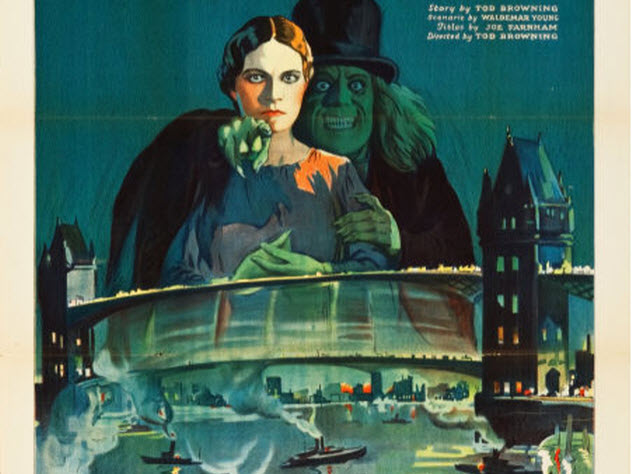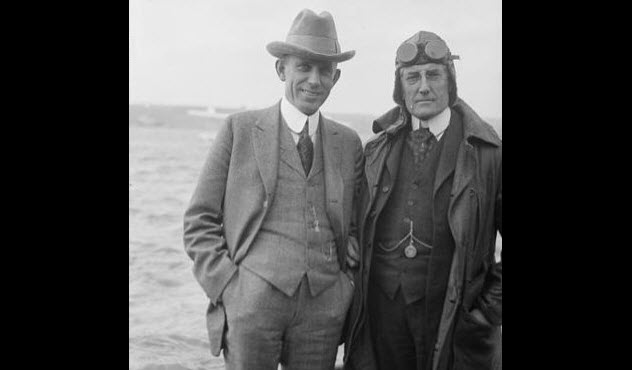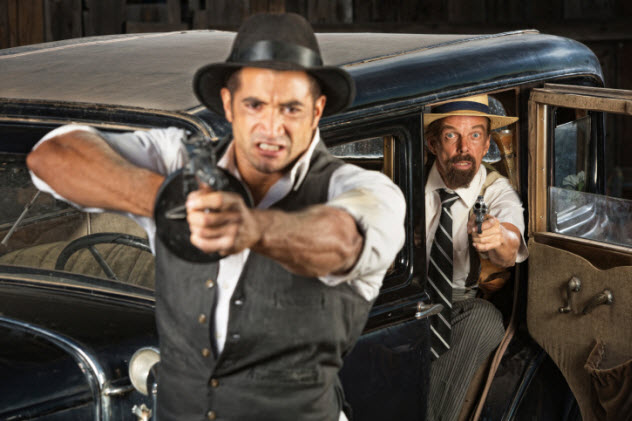 Technology
Technology  Technology
Technology  Humans
Humans 10 Everyday Human Behaviors That Are Actually Survival Instincts
 Animals
Animals 10 Animals That Humiliated and Harmed Historical Leaders
 History
History 10 Most Influential Protests in Modern History
 Creepy
Creepy 10 More Representations of Death from Myth, Legend, and Folktale
 Technology
Technology 10 Scientific Breakthroughs of 2025 That’ll Change Everything
 Our World
Our World 10 Ways Icelandic Culture Makes Other Countries Look Boring
 Misconceptions
Misconceptions 10 Common Misconceptions About the Victorian Era
 Mysteries
Mysteries 10 Strange Unexplained Mysteries of 2025
 Miscellaneous
Miscellaneous 10 of History’s Most Bell-Ringing Finishing Moves
 Technology
Technology Top 10 Everyday Tech Buzzwords That Hide a Darker Past
 Humans
Humans 10 Everyday Human Behaviors That Are Actually Survival Instincts
 Animals
Animals 10 Animals That Humiliated and Harmed Historical Leaders
Who's Behind Listverse?

Jamie Frater
Head Editor
Jamie founded Listverse due to an insatiable desire to share fascinating, obscure, and bizarre facts. He has been a guest speaker on numerous national radio and television stations and is a five time published author.
More About Us History
History 10 Most Influential Protests in Modern History
 Creepy
Creepy 10 More Representations of Death from Myth, Legend, and Folktale
 Technology
Technology 10 Scientific Breakthroughs of 2025 That’ll Change Everything
 Our World
Our World 10 Ways Icelandic Culture Makes Other Countries Look Boring
 Misconceptions
Misconceptions 10 Common Misconceptions About the Victorian Era
 Mysteries
Mysteries 10 Strange Unexplained Mysteries of 2025
 Miscellaneous
Miscellaneous 10 of History’s Most Bell-Ringing Finishing Moves
10 Lesser-Known Murders From The Roaring Twenties
Outwardly, the 1920s was a time of carefree indulgence—the era of hot jazz music, smart twentysomethings with plenty of pocket money, and in America, illicit but easily attainable hooch. It was also the era of gangsters, thieves, and murderers.
Although the tabloid press was filled with sensational stories of sex and crime, some murders from the Roaring Twenties managed to slip through the cracks. These little-known crimes have been in the dark too long. It’s time to shine a light.
10The Case Of The Ragged Stranger

In 1920, Carl Wanderer was just another war veteran recently returned to his native land. The son of German immigrants who had made their home in Chicago, Carl had dropped out of high school to join the army as an enlisted man. Starting as a machine gunner, Carl was promoted all the way to second lieutenant. The former choirboy at Chicago’s Holy Trinity Lutheran Church had seen combat in France during World War I. By most accounts, he was an excellent officer and a good soldier.
When he returned home in 1919, Carl was greeted as a hero. Soon enough, he married Ruth Johnson, a girl he had met at Trinity Lutheran. The newlyweds moved in with her family, which was not unusual at the time, and lived with them until June 21, 1920.
That night, Carl and Ruth were returning home from the movies when an unidentified, shabbily dressed man jumped them. Within seconds, the man fired his gun several times, and Carl shot back with his service revolver. Of the 10 rounds fired that night, most of the bullets hit Ruth, who was several months pregnant. Both Ruth and the perpetrator, whom the press later dubbed the “Ragged Stranger,” died.
Although Carl was a war hero, several investigators and reporters began to smell something fishy in his account of that night. Despite all the shots fired, Carl had emerged without a scratch. Also, the Ragged Stranger had used an expensive handgun—a .45 Colt service revolver—even though he died with little more than $3 in his pocket.
Two Chicago reporters, future Hollywood legends Charles MacArthur and Ben Hecht, discovered that the stranger’s gun had once belonged to Carl’s cousin. Then Hecht found letters written by Carl to a male lover, thus giving Carl a motive to shoot his pregnant wife. In the end, he was found guilty of arranging the death of his wife and the stranger. Carl was executed on September 30, 1921.
9Lady In The Ashes

In 1919, Boston endured a large-scale police strike, a disaster involving an ungodly amount of molasses, and several acts of terrorism associated with the anarchist revolutionary Luigi Galleani. Christmas Day of that year was also the last time anybody saw Alice Arsenault, the owner of a Boston lodging house, alive. On May 12, 1920, her decomposing body was found by the new owners underneath a pile of ashes in the cellar of the lodging house.
Police investigators immediately zeroed in on Greek immigrant Paul Pappas, a tenant in Arsenault’s house who was also her lover. Pappas, whose real surname was Daskalakis, had argued with Arsenault on that fateful Christmas Day before fleeing to Montreal. Apparently enraged that Arsenault had given someone else a present on Christmas instead of him, Pappas had stabbed her several times before burying her body in the basement. On July 14, 1923, Pappas died in the electric chair.
8The Murder Of Julia Mangan

When Irish housewife Julia Mangan set out on the night of October 23, 1928, she probably just wanted some quiet time alone in London’s Hyde Park. Unfortunately, Welsh carpenter Robert Williams was also in the park that night. Inexplicably, Williams attacked Mangan with a razor and then tried to take his own life. At his trial, Williams made a startling confession: Before murdering Mangan, he had gone temporarily insane after watching Lon Chaney’s performance in the film London After Midnight.
A horror-mystery film produced and directed by Tod Browning, London After Midnight is now one of the most sought-after lost films in the world. In the movie, when Roger Balfour is found dead in his London home, Scotland Yard Inspector Edward C. Burke (played by Lon Chaney) is called to investigate. Initially, Burke finds a suicide note and closes the case.
Five years later, new tenants at the Balfour estate appear—a hideous vampire and a ghostly woman. Fearing that the vampire was involved with the earlier murder, Lucille Balfour and Sir James Hamlin once again call upon Inspector Burke. Ultimately, after many terrifying scenes, the vampire is revealed to be Burke, who uses hypnotism and a crime scene reenactment to show that Sir James killed Roger Balfour.
At his trial, Williams, who also claimed that he heard voices in his head, was found competent to stand trial. He was sentenced to death but later received a reprieve.
7The Murder Of Nelson Rehmeyer
In 1927, John Blymire of York County, Pennsylvania, who had just experienced a year’s worth of bad luck, believed that he was the victim of a hex by one of the area’s many Pennsylvania Dutch pow-wow doctors, who are like shamanic healers. After consulting with Nellie Noll, a pow-wow practitioner known as the “River Witch,” he became convinced that his neighbor Nelson Rehmeyer was responsible for the hex. Blymire then persuaded two teenagers that Rehmeyer was also to blame for their failing crops.
On the night of November 27, the three men confronted Rehmeyer in his home and demanded that he hand over some of his hair and his spellbook. When Rehmeyer refused, the trio tortured him, tied him to a chair, and burned down his house.
At the 1928 trial, it was revealed that both Blymire and Rehmeyer were self-proclaimed witches, thus giving many outsiders the skewed view that Pennsylvania’s German community was a hotbed of satanism. For the crime, Blymire received life imprisonment while both teenagers were released in 1939 due to good behavior.
6The Shooting Of Dexter Elliott Chipps

Long before Joel Osteen, J. Frank Norris (pictured above, left) presided over First Baptist, a popular “megachurch” in Fort Worth, Texas. A firebrand and fundamentalist Baptist preacher, Norris oversaw an empire that included a weekly newspaper delivered to about 50,000 homes and a radio station that broadcast to millions of listeners. By 1924, Norris was also the leader of the largest Protestant church in the US.
Norris’s rise was controversial because the flamboyant preacher had been brought to trial twice, once for perjury and once for arson, before achieving stardom. Although he was acquitted in both cases, many in Texas still believed that he was more of a criminal than a man of God. Those naysayers had extra fuel for their dislike when Norris shot and killed Dexter Elliott Chipps, an unarmed lumberman, in July 1926.
A friend of Fort Worth Mayor H.C. Meacham, whom Norris routinely denounced in his sermons as a Roman Catholic (which was considered an insult back then), Chipps was visiting Norris’s office at the time of the shooting.
When the police chief arrived on the scene, Norris claimed that he had shot Chipps in self-defense. This claim was not only corroborated by an eyewitness but was also the final verdict of the jury in Norris’s trial. Once again, many believed that Norris had gotten away with a crime.
5The Last Woman To Be Hanged In Scotland

Born Susan McAllister into crippling poverty in the Scottish resort town of Oban, Susan Newell first began working a series of low-wage jobs in Glasgow after leaving school at age 17. Tragically, her first husband, John McLeod, was killed in World War I, which meant that Susan had to raise their daughter, Janet, alone. By 1923, Susan was remarried and living in a Glasgow suburb with her husband, John Newell, and a now eight-year-old Janet.
By all accounts, the relationship between Susan and John Newell was a tempestuous one. While John was a drunk and a womanizer, Susan had a fiery temper and frequently got into raucous arguments with John. On June 19, 1923, Susan and John’s argument escalated into a beating so severe that John reported his wounds to the police. The next day, he went to his sister’s house to avoid Susan.
At around 6:45 PM on June 20, a 13-year-old paperboy named John Johnson knocked on the Newell family’s door and offered Susan the evening paper. When Susan accepted the paper without paying for it, the young paperboy insisted that the older woman had to pay for her paper. In a rage, Susan strangled the young boy to death. Then she recruited Janet to help her wrap the body in a rug. Eventually, mother and daughter dumped the boy’s body into an old pram before a dangling foot gave away the crime.
During the trial, Susan Newell accused her husband of the murder. When his alibi proved this accusation false, Susan resorted to pleading insanity. The jury was inclined to believe this, even after delivering a guilty verdict. The Scottish authorities, however, decided upon death, and Susan Newell was executed 10 months after her trial.
4Peter Kudzinowski

Peter Kudzinowski was a Polish immigrant who worked as a coal miner and a railroad section hand. He also carried out several murders in Pennsylvania and New Jersey. The archetype of the killer drifter, Kudzinowski killed three people between 1924 and 1928: Harry Quinn in Scranton in 1924, Joseph Storelli in 1928, and Julia Mlodzianowski in 1928.
The murder of Storelli was particularly gruesome because Kudzinowski, who liked to molest children, met the seven-year-old boy on First Avenue in New York City. After treating him to a movie and a trip to Jersey City, Kudzinowski took the youngster to a swamp near Secaucus, New Jersey. There, Kudzinowski struck the boy several times before slitting his throat.
Due to Kudzinowski’s predilection for preying on children, he was also considered a suspect in the disappearance of Billy Gaffney, who turned out to be a victim of the cannibal Albert Fish. After being apprehended in Detroit, Kudzinowski confessed to the murder of Joseph Storelli. A New Jersey jury later sentenced him to death, and in 1929, Kudzinowski was executed at the state prison in Trenton.
3The Murder Of Joseph Bowne Elwell

Joseph Bowne Elwell was almost a caricature of a well-heeled Knickerbocker. A New York City man who was well-known throughout the US as an expert on the game of bridge, Elwell was a published author, a successful gambler, and a prodigious ladies’ man. The latter habit may have gotten him killed.
When Elwell’s housekeeper arrived on the morning of June 11, 1920, she found her employer slumped over in the living room. Beside his chair was a pile of unopened mail. In Elwell’s lap was an opened letter. The final piece of the puzzle was the bullet hole in Elwell’s head.
After police arrived on the scene, they found the bullet’s casing on the floor in a position that looked staged. Also, police discovered that the killer must have crouched in front of Elwell when he or she pulled the trigger. With no signs of forced entry, it appeared that Elwell knew his killer.
The murder drew headlines almost immediately. Some speculated that Elwell was a Jekyll and Hyde who vacillated between cordiality and viciousness. On April 11, 1921, the case took a bizarre turn when Roy Harris confessed to the murder. Harris’s confession was debunked by his wife, who told police that her husband had been with her the entire day of the murder. The case remains unsolved.
2The Milaflores Massacre

Before March 1927, Detroit’s Purple Gang, a mostly Jewish-American gang associated with corrupt members of the American Federation of Labor, ran the Cleaners and Dyers Association as a racketeering enterprise. The Purple Gang was adept at bootlegging and strong-arming workers into joining their corrupt labor unions. They were also one of the first Prohibition-era criminal outfits to commit murder using a tommy gun.
What became known as the “Milaflores Massacre” began when burglars Frank Wright, Joseph Bloom, and George Cohen began kidnapping Detroit gangsters for ransom. Many of these gangsters were associated with the Purple Gang—such as Johnny Reid and Jake Weinberg, who were killed in 1926 and 1927, respectively. Incensed by these audacious crimes, the Purple Gang vowed revenge.
At about 4:45 AM on March 28, 1927, Fred “Killer” Burke, a former member of the infamous St. Louis gang Egan’s Rats, opened fire with a Thompson submachine gun at the Milaflores Apartments in Detroit. Inside were Wright, Bloom, and Cohen. Bloom and Cohen were shot so much that their bodies were almost cut in half. Despite suffering 14 .45-caliber gunshot wounds, Wright managed to hang on for a while. Before dying, he supposedly told the hospital staff that “the machine gun worked.” Although the case was never officially solved, everyone in Detroit knew that it was the work of the Purple Gang.
1The Butterfly Murders

Dorothy King and Louise Lawson were young, pretty, and eager for fame. King was an aspiring stage celebrity who had grown up in Harlem with poor Irish immigrant parents. Lawson, a native of Walnut Springs, Texas, was an aspiring film actress.
During the early 1920s, both women separately went to New York to make it big on Broadway. They were later dubbed “butterflies” by the New York press because of their attraction to the bright lights of the big city.
On March 15, 1923, King was found chloroformed to death at the age of 29. After discovering her body, her maid also noticed that King’s room had been ransacked. A close search determined that an ermine coat and several valuable jewels were missing. Investigators initially believed that King may have committed suicide because chloroform was a party drug in the 1920s. But an autopsy proved without a doubt that she had been murdered.
As the newspaper headlines asked “Who Murdered the Broadway Butterfly?” detectives looked into King’s wealthy benefactors and the men who paid for her company. Two major suspects appeared—J. Kearsley Mitchell, the president of the Philadelphia Rubber Works who frequently used the alias “John Marshall,” and a Puerto Rican gigolo named Albert Guimares.
Sugar daddy Mitchell was deemed respectable and written off as a suspect. Guimares initially claimed to have a blonde alibi, but she later recanted her testimony on behalf of Guimares. Despite this lead, detectives could not close the case, and many wrote off the murder as the work of professional thieves.
On February 8, 1924, Lawson, who was known for performing private shows for rich men, was found strangled to death in her New York apartment. Like King, Lawson’s dead body was discovered by her maid, who also noticed that about $20,000 worth of jewelry was missing. Again, police assumed that Lawson’s death had come as the result of a robbery. But many people still question whether King and Lawson were killed by the same man.
Benjamin Welton is a freelance writer based in Boston. His work has appeared in The Atlantic, The Weekly Standard, Listverse, Metal Injection, and others. He currently blogs at literarytrebuchet.blogspot.com.








